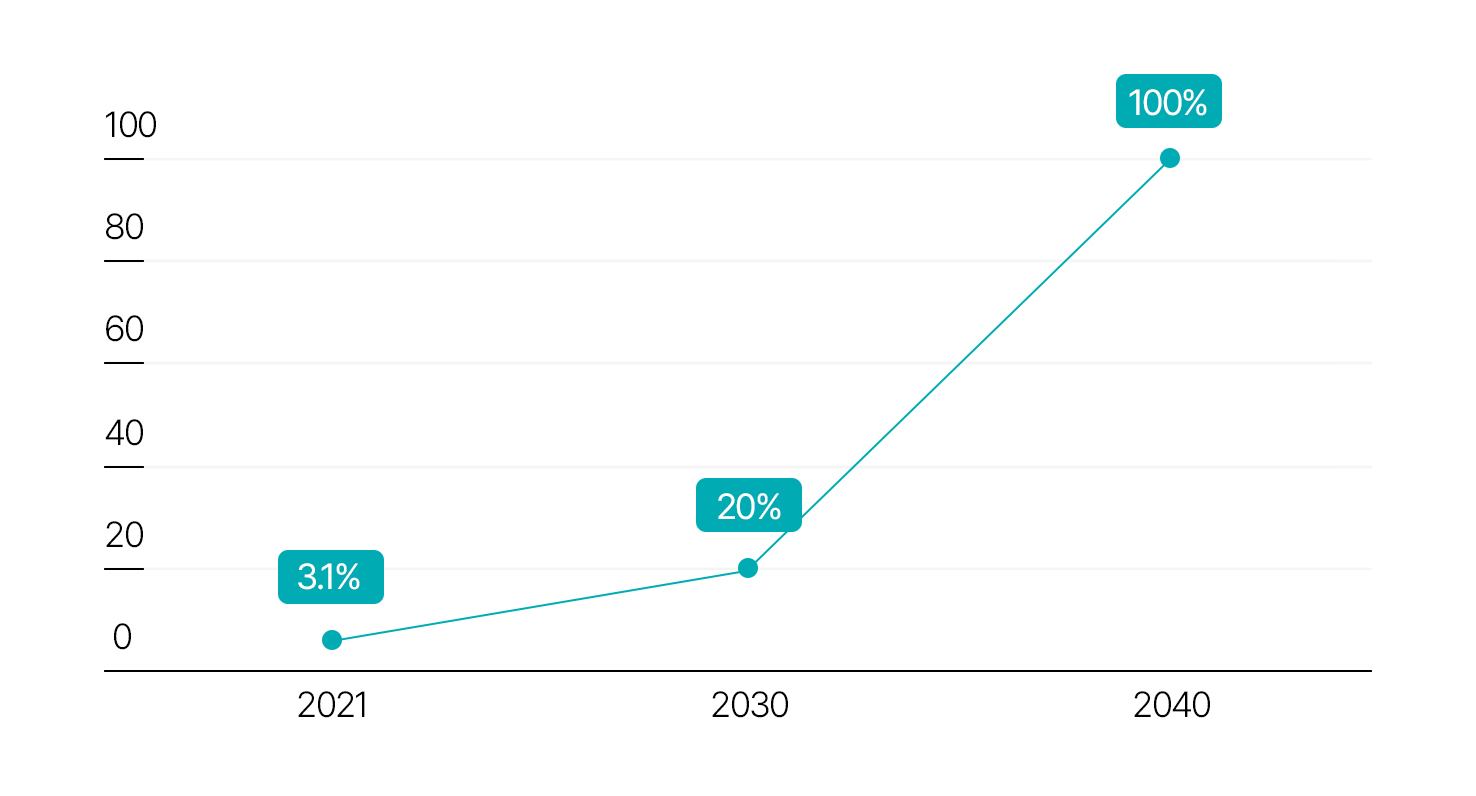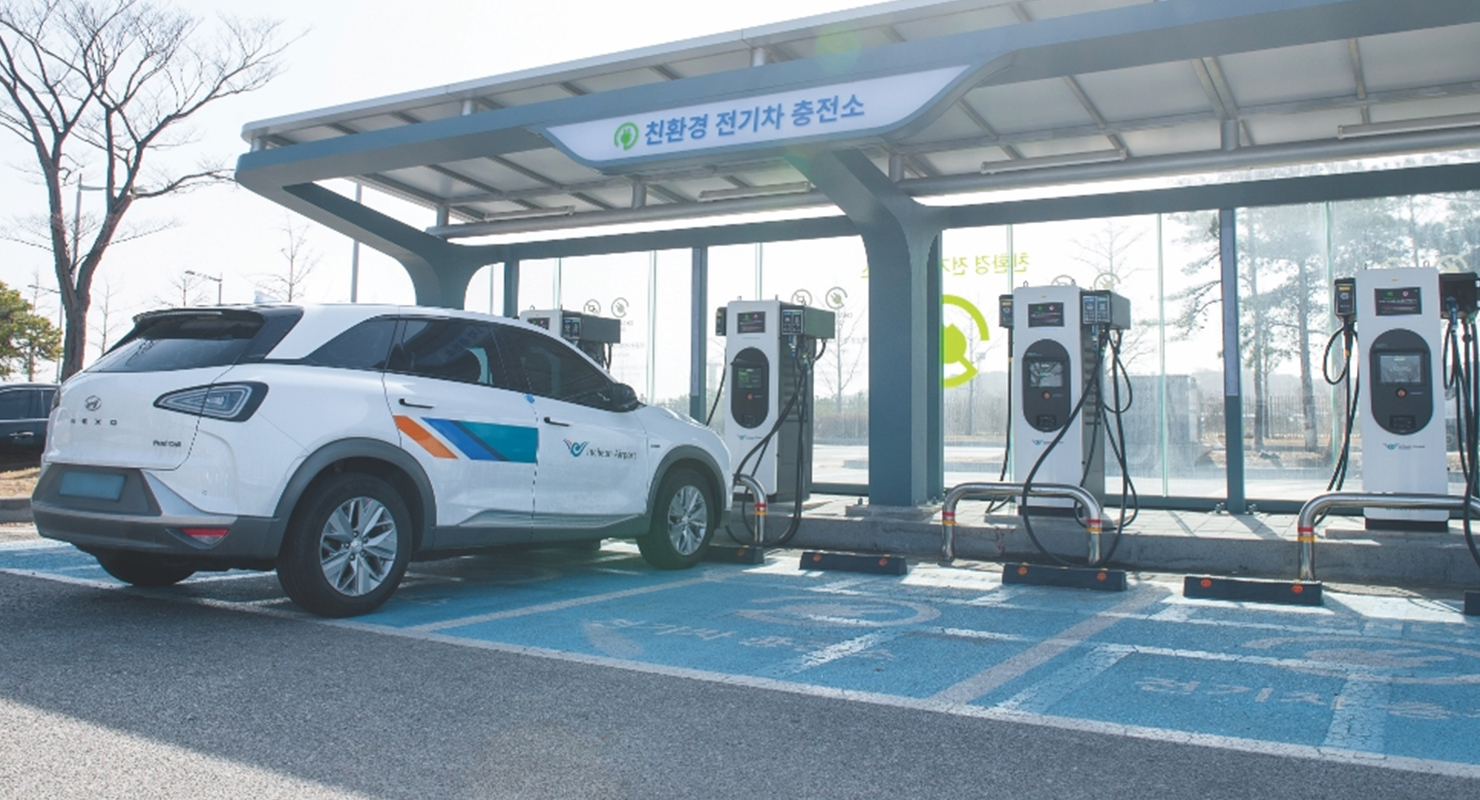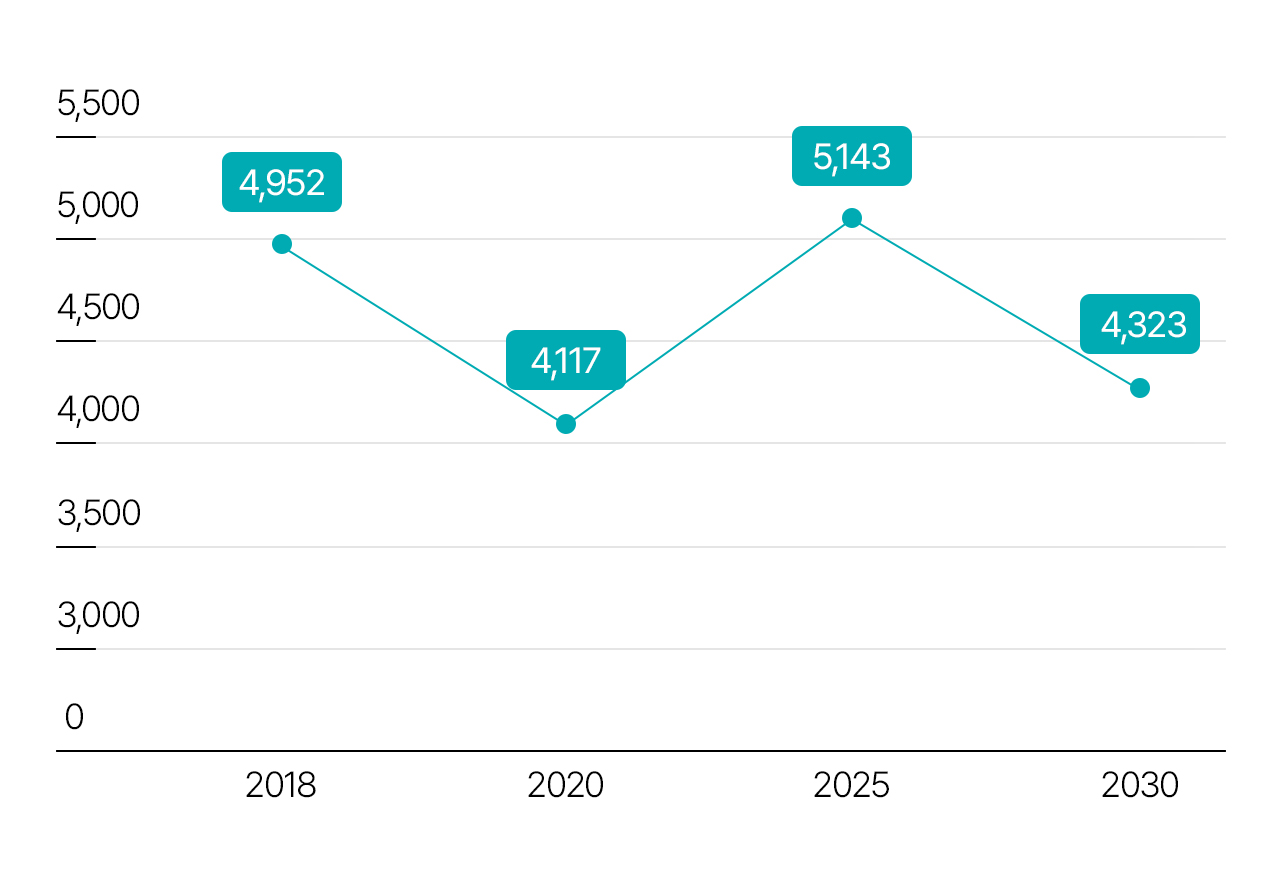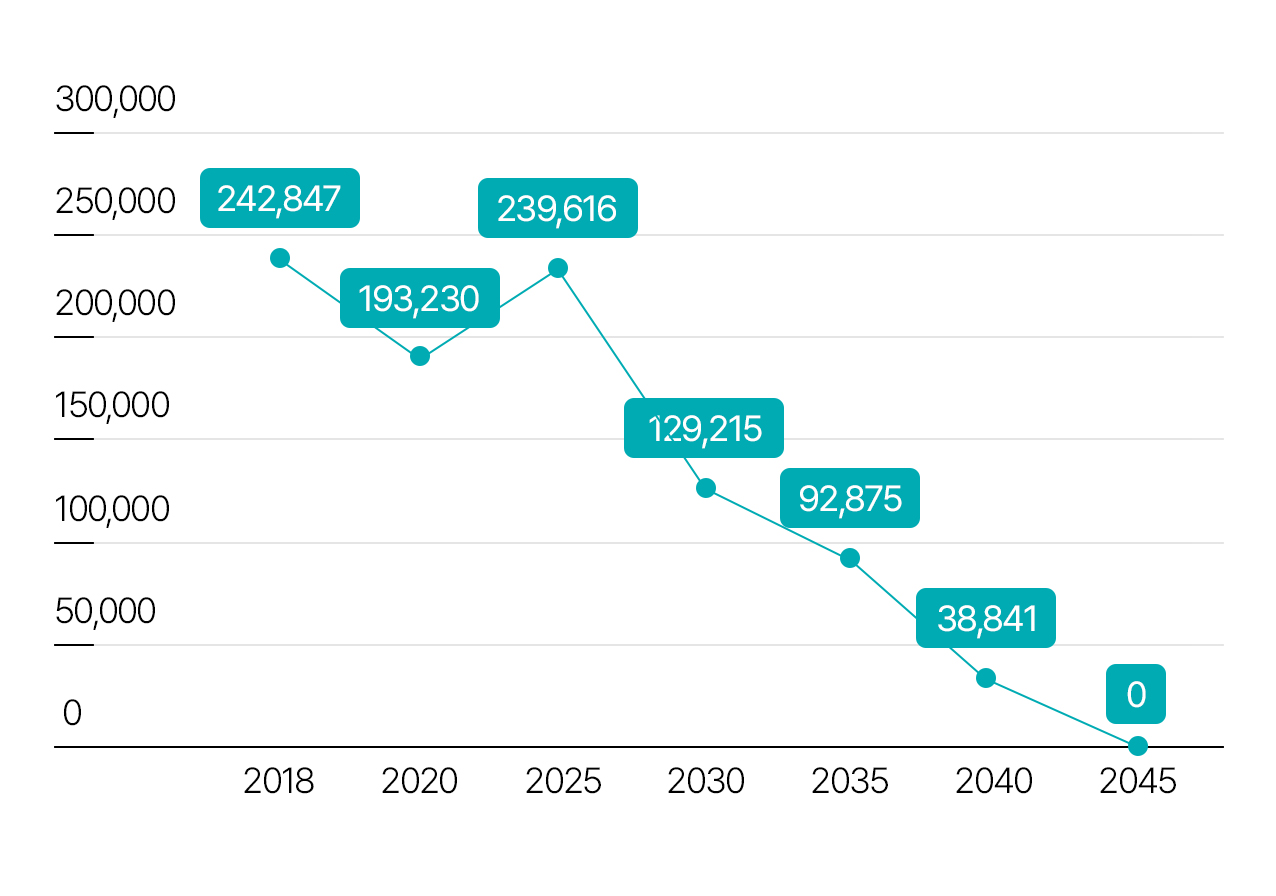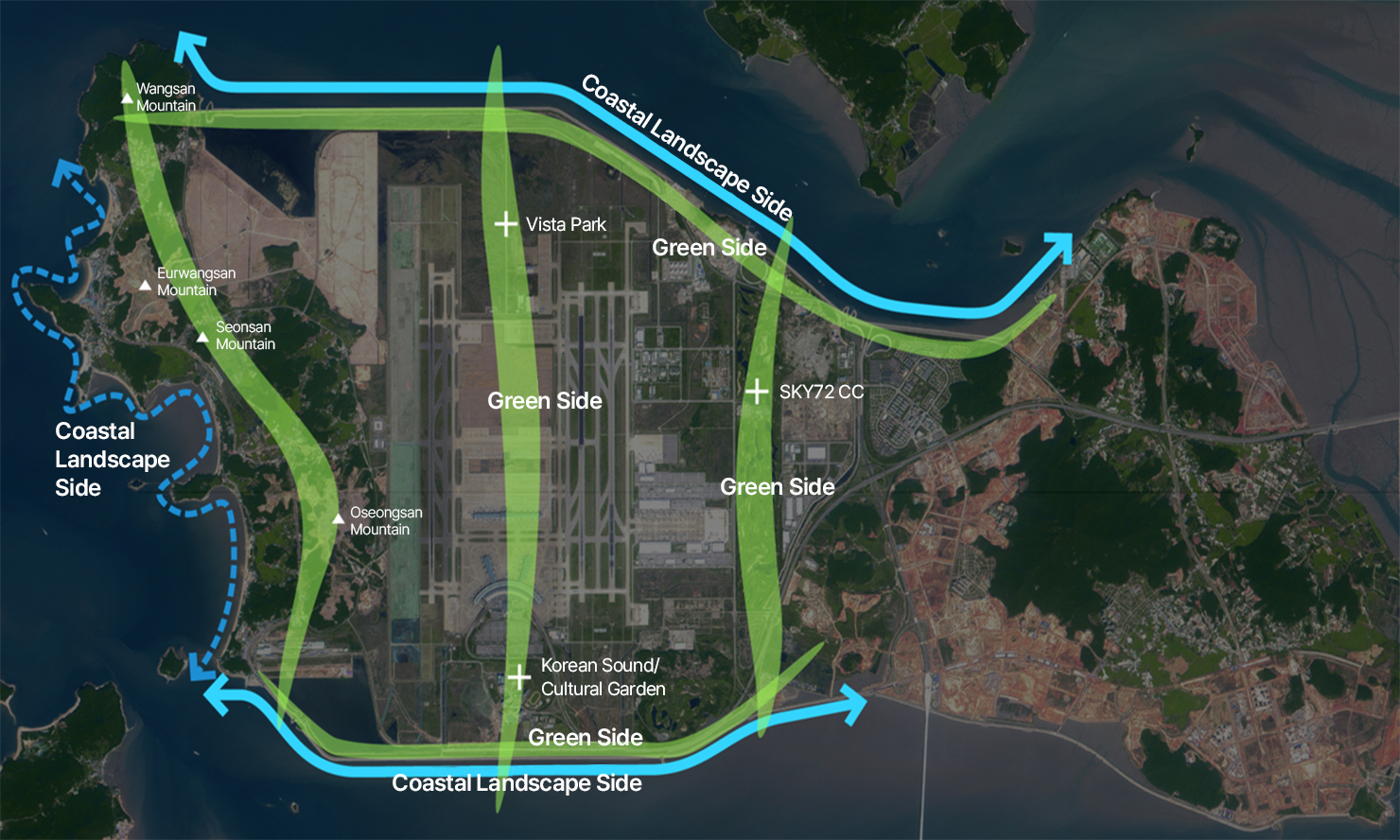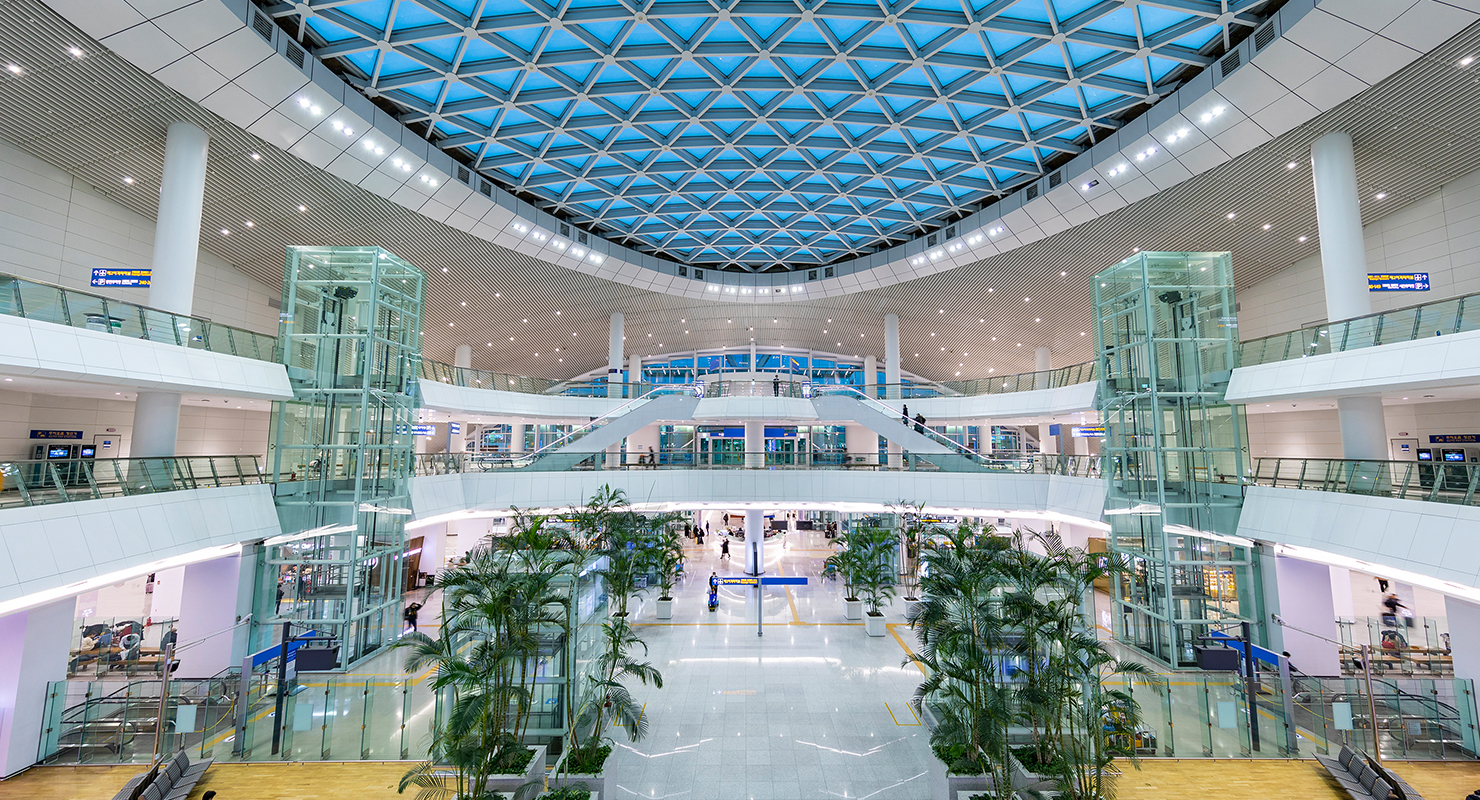E: Implementing a Low-Carbon Eco-Friendly Airport
Go to Green ReportTo transition from energy consumption to energy independence, Incheon Airport is seeking 100% conversion into renewable energy by 2040, moving towards a low-carbon eco-friendly airport.

Job Creation
First Airport in Asia to Join RE100
Incheon Airport is the first among over 2,500 airports in Asia to join RE100. Leading the global airport ecosystem in the shift towards renewable energy, Incheon Airport sets the pace.
RE100 (Renewable Energy 100)
RE100: a voluntary campaign wherein companies commit to replacing 100% of the electricity they consume with renewable energy generated from solar and geothermal power.
-
300+ Member
More than 300 companies worldwide are participating in the RE100 campaign.
-
175+ Markets
Companies that have joined RE100 commit to implementing RE100 in 175 markets across the globe.
-
330+ TWH/year
Companies participating in RE100 are replacing over 330 terawatt-hours of electricity consumption annually with renewable energy.
Energy Independence
Through the development of renewable energy facilities and purchase of eco-friendly electricity, Incheon Airport is advancing towards an energy-independent airport.
Incheon Airport’s Energy Facilities
-
North Side Area including Terminal 2(4 sites)
3.8 -
South Side Area including Terminal 1 (10 sites)
1.2 -
East Side Area including Cargo Terminal (5 sites)
2.0 -
West Side Area including Solar Power Plant (3 sites)
3.5
-
North Side Area including Terminal 2 (3 sites)
6.4 -
East Side Area including Free Trade Area (1 site)
0.1 -
West Side Area including the Incheon Airport Aviation Academy (3 sites)
1.5
Globally Recognized Eco-Friendly Management of Incheon Airport
Incheon Airport has been recognized by reputable organizations such as ACI for excellence in energy management, environmental management, and carbon emission control.

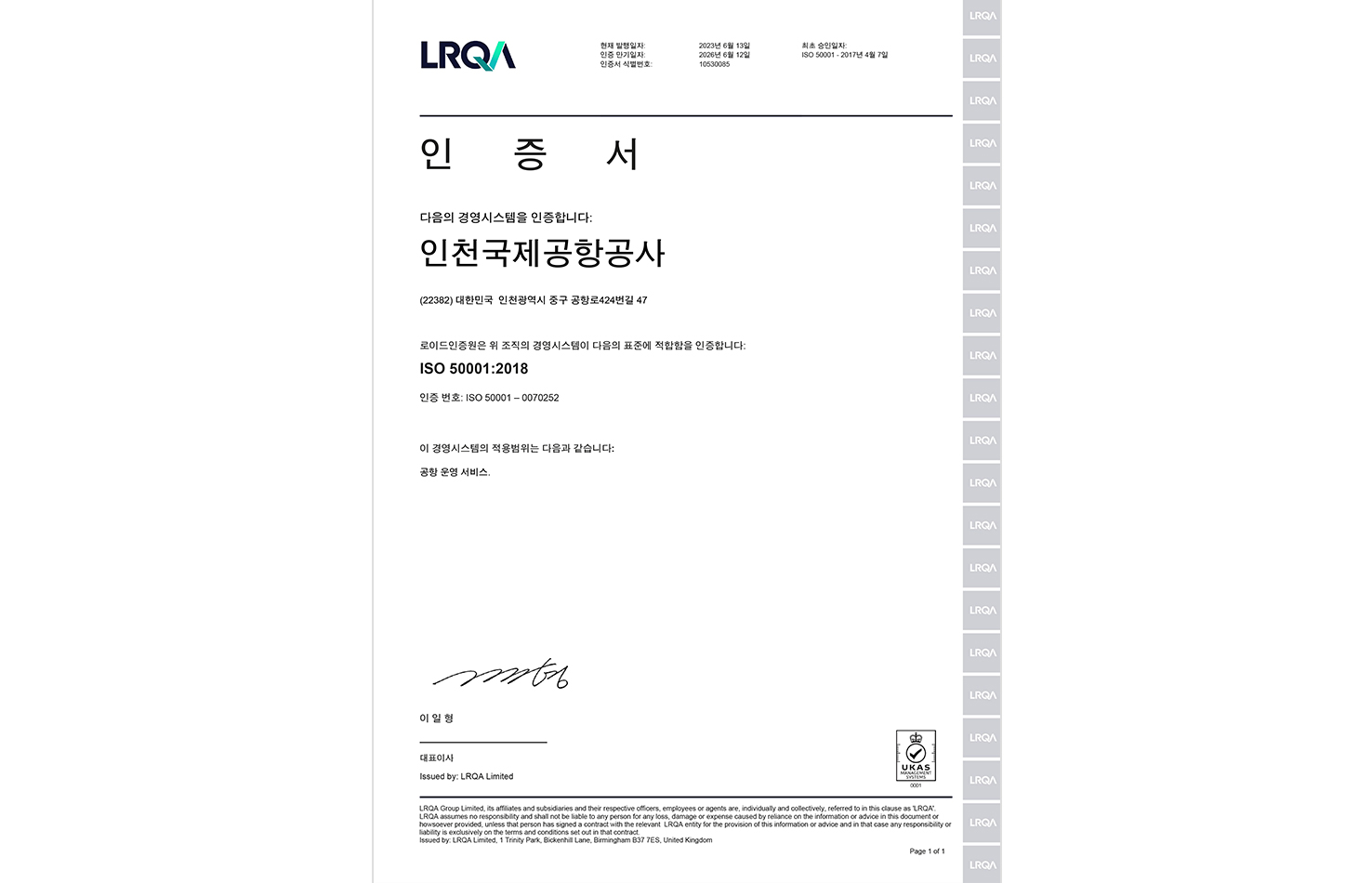
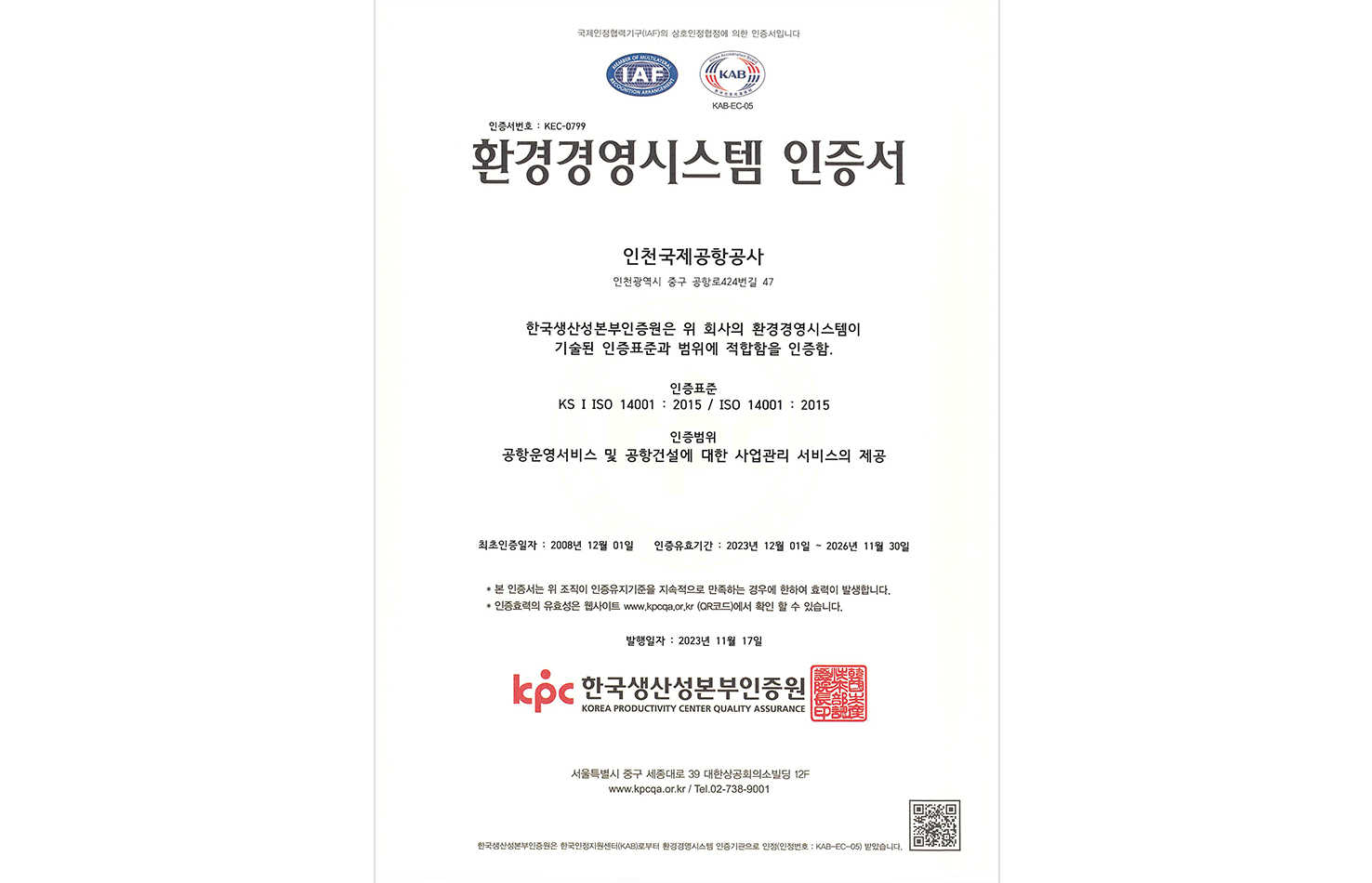
Green Mobility
ECO CAR: Incheon Airport, the Paradise of Eco-Friendly Vehicles
Incheon Airport operates the largest fleet and infrastructure of eco-friendly vehicles in the country.
- 100%
Transition of Company Vehicles to Eco-Friendly Vehicles
- 895Units
Installation of Electric Vehicle Charging Stations (by 2030)
- 1000kg/day
Largest Hydrogen Charging Station in the Country
Fast and Easy Charging for EVs and Hydrogen Cars
With the most extensive electric and hydrogen vehicle infrastructure in Korea, Incheon Airport offers convenient charging and parking for all eco-friendly vehicle users.
-
Facility Capacity
 T1 Hydrogen Charging Station 250kg/dayT2 Hydrogen Charging Station 1,000kg/day
T1 Hydrogen Charging Station 250kg/dayT2 Hydrogen Charging Station 1,000kg/day -
Operating Hours
 8:00~22:00 (Open All Year Round)
8:00~22:00 (Open All Year Round)
-
88 Units
 As of 2021 Electric Vehicle Chargers
As of 2021 Electric Vehicle Chargers -
2 locations
 As of 2021 Hydrogen Charging Stations
As of 2021 Hydrogen Charging Stations
Turning Airport Vehicles into Eco-Friendly Ones
All company vehicles and shuttle buses managed by Incheon Airport have been fully converted into eco-friendly vehicles.
-
Completion of 100% Conversion
 Company Vehicles
Company Vehicles
- 50UnitsElectric Vehicles
- 84UnitsHydrogen Vehicles
- 30UnitsHybrid Vehicles
-
Completion of 100% Low-Emission Conversion
 Shuttle Buses
Shuttle Buses
Plan to introduce 10additional hydrogen shuttle buses(by 2025)
Status of Eco-Friendly Conversion of Vehicles Operating in the Airport Area (2021)
Acceleration of Eco-Friendly Conversion of Diesel-Powered Equipment
Charging infrastructure is being established to enable businesses to operate eco-friendly equipment and vehicles without causing any inconvenience in the aircraft movement area.
Eco-Friendly Conversion of Diesel-powered Equipment
- Conversion Rate
- 2025 32%
- 2028 65%
- 2030 100%
Roadmap Towards a Carbon-Neutral Airport
To create a globally leading carbon-neutral airport, energy consumption reduction goals and greenhouse gas reduction goals are being set, with an international-level carbon management system in place.
Energy Consumption Reduction Goals
| Category | Consumption (Target) | Reduction Compared to 2018 |
|---|---|---|
| 2018 | 4,952 | |
| 2020 | 4,117 | -835 |
| 2025 | 5,143 | 191 |
| 2030 | 4,323 | -629 |
Greenhouse Gas Reduction Goals
| Category | Emissions (Goal) | Reduction Compared to 2018 |
|---|---|---|
| 2018 | 242,847 | |
| 2020 | 193,230 | -49,617 |
| 2025 | 239,616 | -3,231 |
| 2030 | 129,215 | -113,632 |
| 2035 | 92,875 | -149,972 |
| 2040 | 38,841 | -204,006 |
| 2045 | 0 | -242,847 |
Key to Reducing Aviation Carbon: Biofuel
Incheon Airport is building a wide range of infrastructures to construct a biofuel supply system, which is emerging as a key solution for reducing carbon emissions in the aviation industry.
To Ensure that Not a Drop of Fuel is Wasted
Incheon Airport’s operation system minimizes unnecessary movement and supplies ground power until just before takeoff; thus reducing unnecessary fuel consumption and contributing to carbon reduction.
Go to A-CDM-
A-CDM
Collaboration and Integrated Decision-Making System Among Stakeholders in Aircraft Operations
8% Fuel Savings -
AC-GPS, PC-Air
We supply electricity instead of aviation fuel for lighting, air conditioning, etc.
98% Carbon Savings -
Renewal of Airfield Facilities
By repaving runways and constructing new taxiways, ground movement is minimized, leading to fuel savings.
Green Transformation of Airport Infrastructure
Green Transformation of Airport Infrastructure
Through the “5 Green Projects,” which seek to enhance the ecological environment of the airport reclamation area, Incheon Airport improves the quality of life for Yeongjongdo residents and addresses green blind spots.
-
 Future-Ready Forest
Future-Ready ForestSeedling Farms, Event Green Spaces
-
 Ecological Forest
Ecological ForestEcological Meadows, Landscaping Expos
-
 Community-Building Forest
Community-Building ForestNeighborhood Parks, Revenue Generation
- Global, Green
Phase 1 (2020~2022)
Establishment of Idle Land Master Plan, Basic Plan, and Detailed Design
- Growth, Gather
Phase 2 (by 2025)
Creation of Oseong Neighborhood Park, Improvement of Access Roads, and Establishment of Seedling Farms
- Guard
Phase 3 (by 2030)
Completion of Airport Forest Creation
Expected Reduction of CO2 Through 5 Green Projects
The 5 Green Projects are expected to reduce aircraft noise, absorb carbon dioxide and ozone, and decrease fine dust.
Incheon Airport Green Space CO2 Absorption: 2,754 tons/year
| Category | Incheon Airport's Managed Volume | CO2 Absorption (kgCO2/y) | CO2 Absorption (Kg) |
|---|---|---|---|
| Arboreal Trees | 87,881 units | 20 | 1,757,620 |
| Grasslands | 1,557,390m2 | 0.64 | 996,729 |
| Total | 2,754,349 | ||

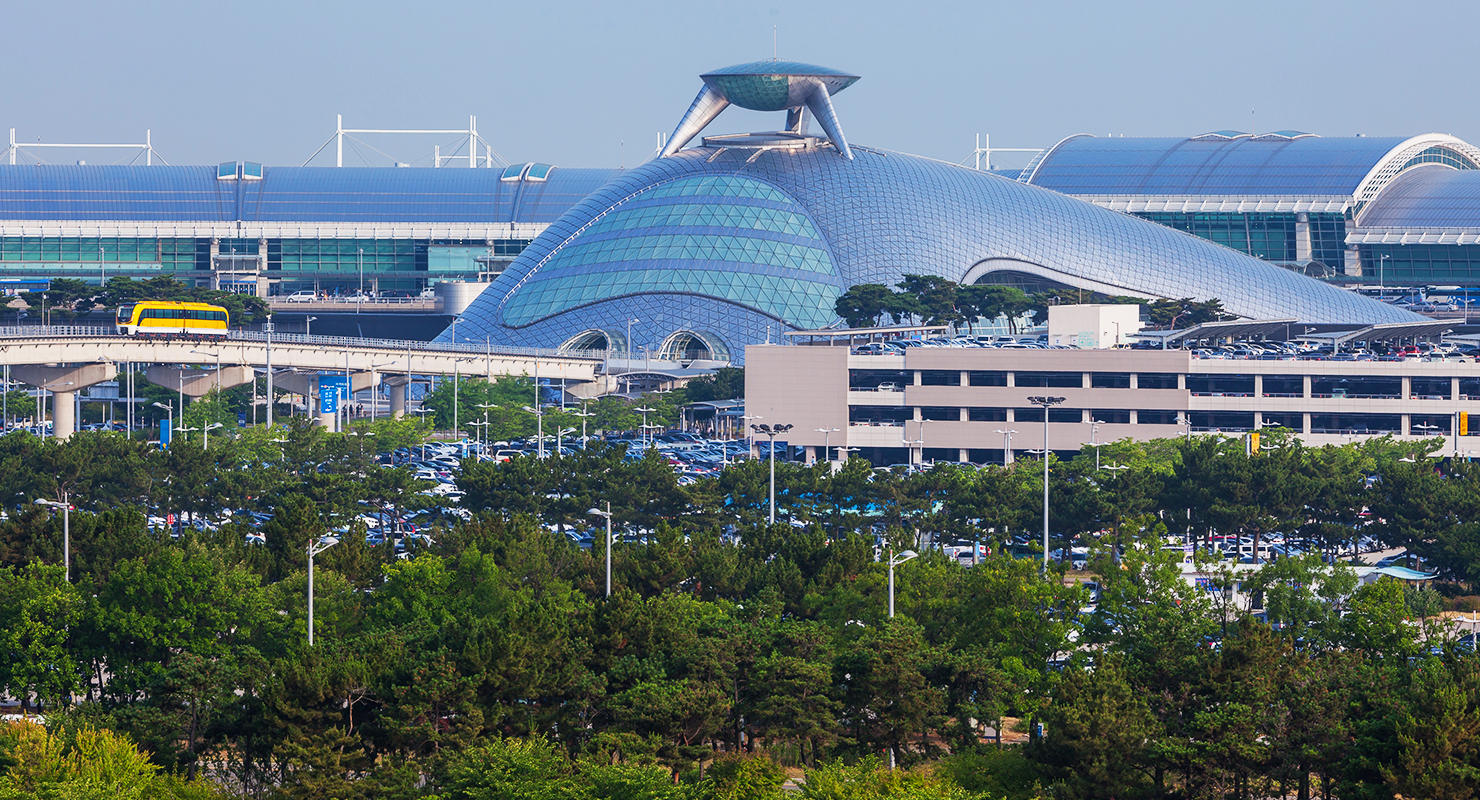
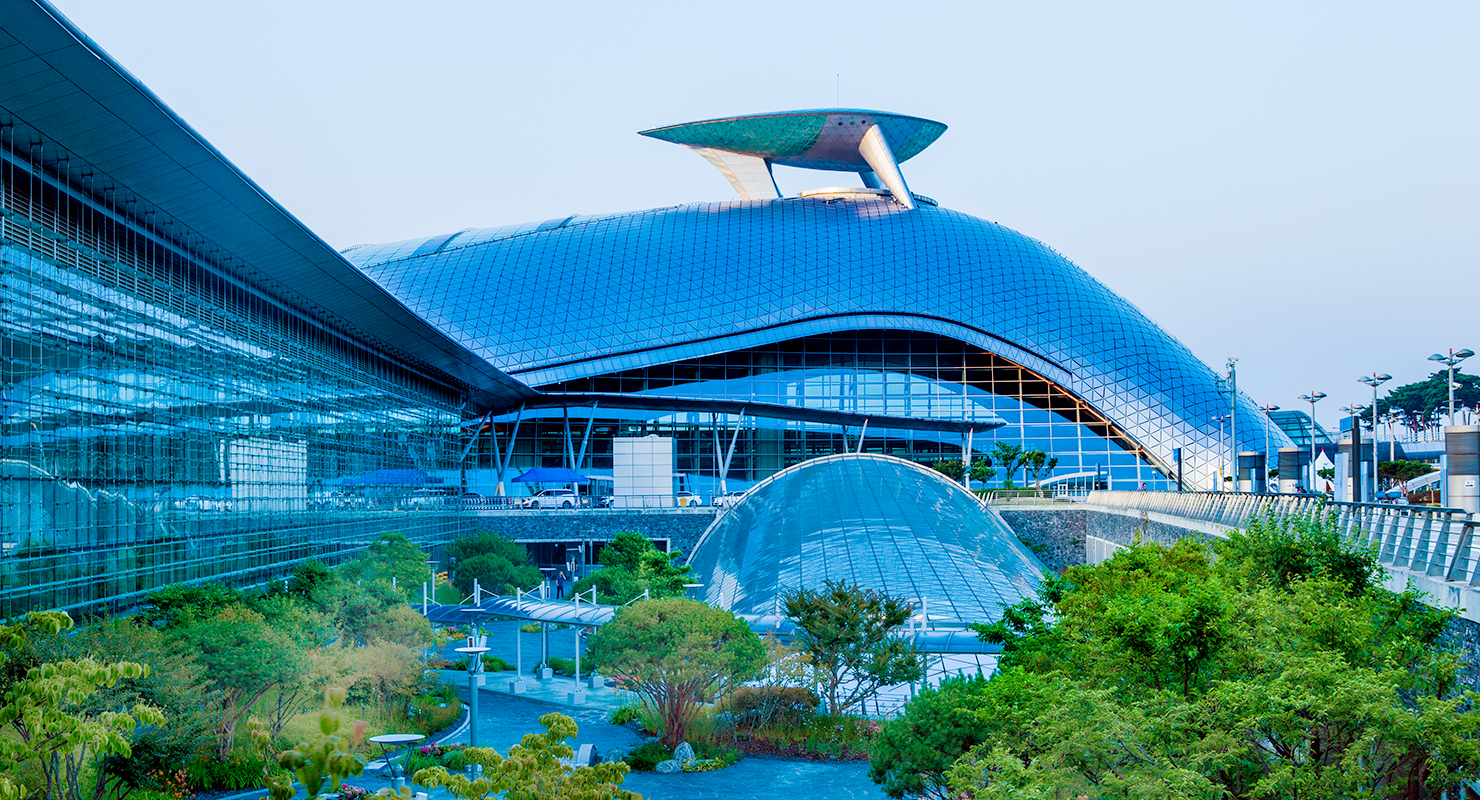


A 7.7 km Green Tunnel (Tree-lined Road) along the access road to the passenger terminal.
Creating surrounding airport forests by increasing the total number of trees and planting density in areas like street trees and central medians.
Creating a tree nursery growing saplings as well as mature trees, creating a scenic forest that recycles local resources for sustainable production.
Constructing Oseong Neighborhood Park (880,000㎡) by 2025, exploring private participation in park operations to create jobs
(event hosting and community offerings)
Reducing aircraft noise by building large-scale tree belts around runways
Maximizing the reduction of particulate matter by introducing excellent CO2- and ozone-absorbing tree species and creating multilayered tree belts
Turn Off Worries of Aircraft Noise
From the construction phase, Incheon Airport was designed as an offshore airport to minimize noise, and it continues to strive to reduce noise through its own monitoring system and the operation of a noise reduction council.
-
Notification Status (Area: km2 )
-
Category 1 Zone (95 WECPNL or higher)
5.943 -
Category 2 Zone (90–95 WECPNL)
4.002 -
Category 3 Zone (75–85 WECPNL)
24.187
-
-
Status of Noise Control Areas and Adjacent Regions (Adjacent Areas: 70WECPNL)
-
Ongjin-gun Bukdo-myeon
-
Jung-gu Deokgyo-dong, Nambuk-dong
-
Incheon Airport is striving to alleviate the inconvenience caused by noise through noise mitigation projects and resident support initiatives.
Aircraft Noise Measurement Results[Visit]-
Noise Mitigation Projects For areas with 75 WECPNL or higher:
Installation of soundproofing and air-conditioning facilities, support for TV license fees/air conditioning electricity fees
-
Resident Support Projects For areas with 70 WECPNL or higher:
Support for income enhancement and welfare projects up to 75% in local governments (Ongjin County, Jung-gu)
(Certain areas of Jangbongdo, Modo, and Yongyudo) -
Community Engagement Projects For areas with 70 WECPNL or higher:
Provision of academic support funds, funeral expenses, free meals, etc.
(Certain areas of Jangbongdo, Modo, and Yongyudo)
The Secret Behind Incheon Airport’s Clear Sky
Incheon Airport ensures a safe, pleasant travel experience for passengers by monitoring air quality within the airport according to its own stringent standards, which are more rigorous than the legal requirements.
Indoor Air Quality Measurement Results[Visit]-
Measurement Points
-
Legal Standards20 locations
-
Internal Standards34 locations
-
-
Measurement Frequency
-
Legal StandardsMaintenance Standard Once a yearRecommended Standard Once every two years
-
Internal StandardsQuarterly
-
-
Measured Items
-
Legal StandardsMaintenance Standard Particulate matter, fine particulate matter, carbon dioxide, formaldehyde, carbon monoxideRecommended Standard Nitrogen dioxide, radon, total volatile organic compounds
-
Internal StandardsAll items
-
Environmental Pollutants and Energy Consumption Related to Airport Operations
- Environmental Pollutants and Energy Consumption Related to Airport Operations (Related to Article 26 of the Airport Environmental Management Standards) Download


